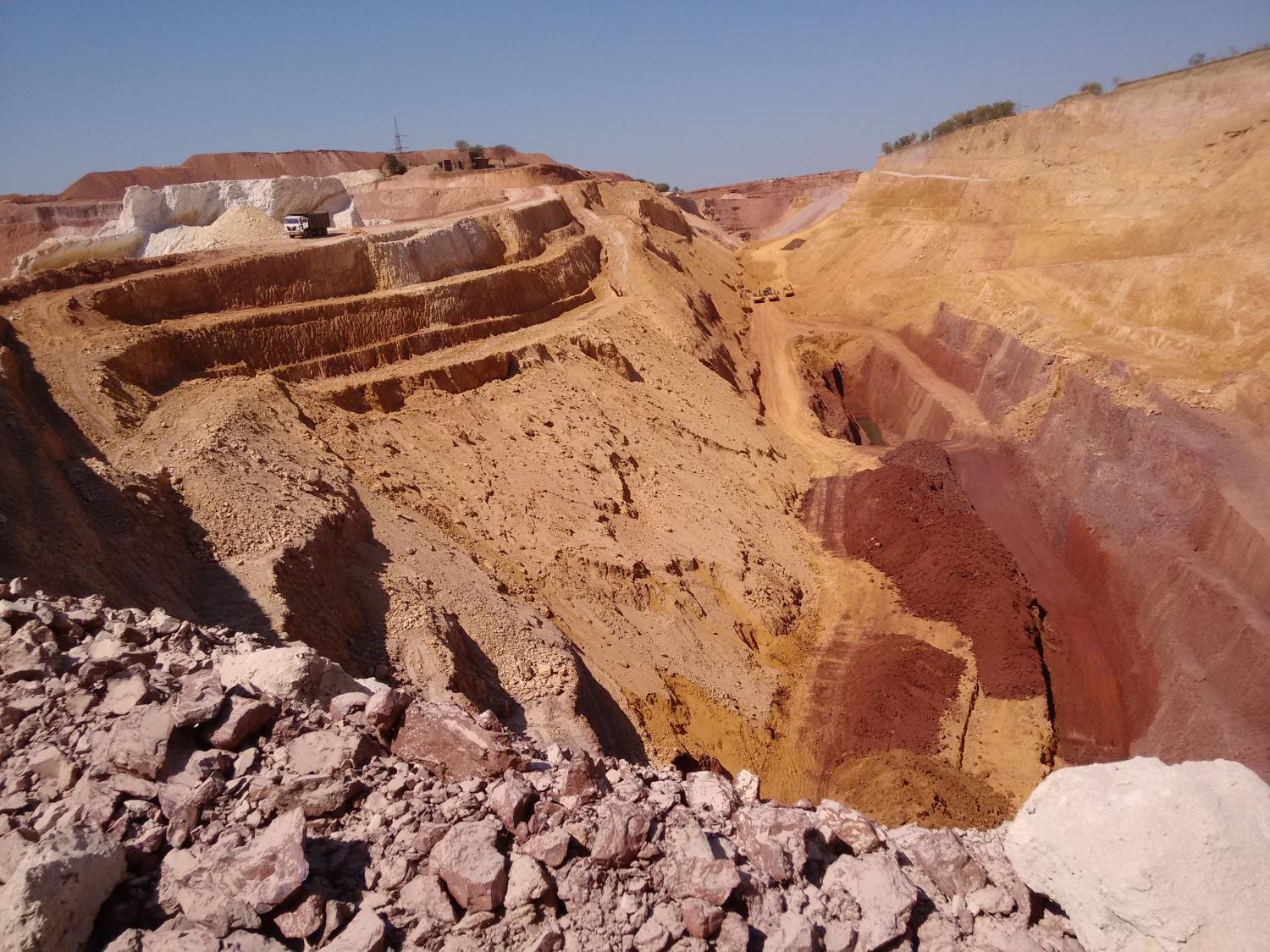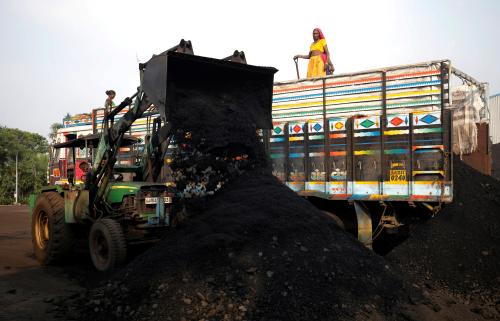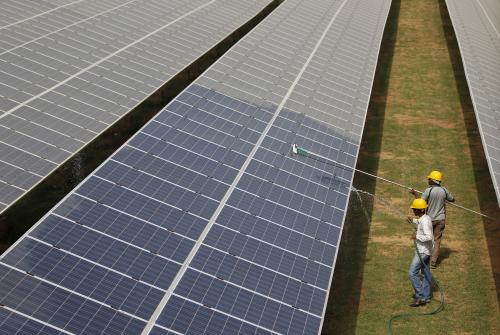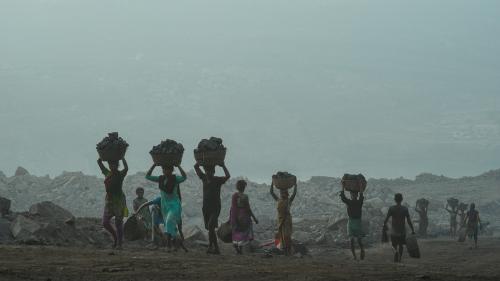Content from the Brookings Institution India Center is now archived. After seven years of an impactful partnership, as of September 11, 2020, Brookings India is now the Centre for Social and Economic Progress, an independent public policy institution based in India.
India has a landmass of 3.2 million km with a multitude of geological – tectonic domains, which evolved through the entire course of geological past and developed varied mineral potential. India also has a significant legacy of mining from pre-historic times which continues to this day.
For centuries, India produced iron ore, copper, zinc, lead, gold, silver, diamonds, and other precious gemstones and fascinating facing and building stones which are visible in our historical architecture. While in British colonial times, mining of precious metals and stones, as well as of coal (and petroleum) was the twin focus, it also laid the foundations of modern geological studies in India through the establishment of the Geological Survey of India (GSI) and institutions such as the Presidency College of Calcutta, which housed India’s first geology departments. Large iron ore deposits were discovered by the pioneering GSI geologists in eastern, central, and southern India towards the beginning of the 20th century and entrepreneurs like Jamshed Ji Tata accepted the challenge of setting up the foundations of India’s steel industry. The British also started the great geodetic survey of the South Asian region, while the GSI started the geological mapping of the entire sub-continent.
This spectacular legacy of geological mapping and survey continued post-independence, as India embarked on the path of rapid industrial growth and development. India’s bulk mineral commodities like iron ore, coal, manganese, limestone and later, bauxite contributed to India’s infrastructural development. Most of the major minerals in the country were produced by India’s public sector units (PSUs). GSI, Mineral Exploration Corporation Limited (MECL), and later, Coal Mine Planning and Development Institute (CMPDI), a subsidiary of Coal India Limited (CIL), took up the cudgels of mineral exploration in the country. Together, GSI and CMPDI carried out significant explorations in defining the coal resources of India.
However, most of the bulk commodities were either dispensed as Mining Leases (ML) to PSUs or allocated to the private sector with minimal exploration data. Very limited mineral exploration was carried out for bulk commodities by the ML holders in the last 70 years, which unfortunately resulted in a significant gap towards the conversion of geological resources to mineable reserves. Even the GSI carried out very limited exploration for bulk commodities once large areas were dispensed for ML in any of the mineral districts. Thus, many greenfield areas are yet to be explored even for bulk commodities. For non-bulk commodities, there was focused exploration in some of the mineral districts such as the Aravallis and Singbhum Sheared Zone (for base-metals), the Dharwar Craton for gold, and others. These led to the discovery of many medium to small mineral deposits, only a few of which were converted to mines. However, India remained grossly under-explored for both bulk and non-bulk commodities compared to the rest of the world. Exploration spending in India remained less than US$100 million annually, while the top exploration domains in the world such as Canada, Australia, Southern America, China, Western Africa, SE Asia received hundreds of millions of dollars of exploration investments annually. A general estimation is that India had detailed exploration in less than 10% of the total Obvious Geological Potential area.
The liberalisation of India’s economy in 1991 progressively opened India’s major minerals sector to private sector investments. PSUs like Hindustan Zinc Limited (HZL) and Bharat Aluminium Company Limited (BALCO) were disinvested through private sector investments and many coal blocks were allocated for private sector captive development. India made significant changes to the Mines and Minerals Development and Regulation (MMDR), 1957 Act to align the same with the minerals code of the best-known minerals jurisdictions, which allowed private sector investments for mineral exploration in India on assets dispensed on First Come First Serve (FCFS) basis. In about 13 years of exploration, in different phases in different parts of India, since MMDR 1993 and its modified versions were implemented, few large and some of the junior Indian and international companies including Rio Tinto, De Beers, BHP Billiton, Anglo American, Phelps Dodge, Geomysore India Limited established their exploration units in India and carried out limited but high-quality modern integrated exploration including airborne and ground geophysics, sophisticated remote sensing, geochemistry, and detailed drilling programs. Rio Tinto and De Beers were the most successful in making many discoveries of kimberlites – the source rocks for diamonds. Rio Tinto’s Bunder Diamond discovery is hailed as one of the largest clusters of diamond deposits found in the last two decades, globally. Additionally, few gold and base metal deposits were also discovered. HZL, which was disinvested to Vedanta Group, added more than 200 million tonnes of additional lead and zinc Geological Resource in Rampura Agucha to make it the world’s largest zinc–lead deposit. HZL also discovered brownfield resources at Sindesar Khurd, making it a world-class deposit.
However, India’s mineral exploration came to a near-complete halt after 2010, as none of the states issued exploration licences (RP and PL) to any company till the introduction of the new MMDR Act 2015. Meanwhile, the Supreme Court declared the blocks allocated to private sector lease holders for coal as illegal; soon thereafter, the Shah Commission and the Supreme Court stopped much of the mining activities in the state of Karnataka and Goa, while partially halting mining in the states of Odisha and Jharkhand. The MMDR 2015 (Amendment) Act was brought in to address the major concerns of Supreme Court in terms of lack of transparency, fairness, and objectivity to mineral asset dispensation process. The minerals code envisaged a rigid framework of Mineral Auctions based on Evidence of Mineral Content (EMC) Rule, which necessitated dispensation of a mineral asset for Composite License (CL) or Mining Lease only if the asset has a defined Geological Resource of (United Nations Framework Classification for Resources) UNFC G3, G2, or a higher category. This rule instantly split the minerals value chain into two – the exploration-to-discovery phase of a mineral resource was taken out of the purview of private sector explorers and left to the conventional process of government sponsored exploration; while the resource once discovered by a government-sponsored entity was to be auctioned for exploration to develop further confidence on the Geological Resource, followed by development and mining by a Composite License or a Mining Lease. While some bulk commodity assets were auctioned through the new process, the exploration and discoveries of non-bulk commodities, for most part, reduced to a trickle.
This Discussion Note takes a look at India’s exploration needs in the 21st century, the changes in India’s minerals code to bring in objectivity, fairness and transparency in the mineral asset allocation process, and key initiatives that must be implemented to create a competitive exploration investment environment to achieve the Vision 2035 for the mining sector.






